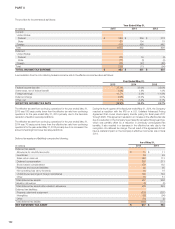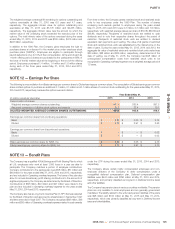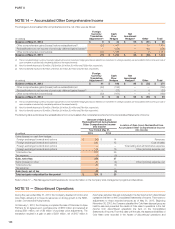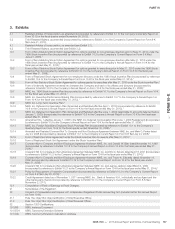Nike 2015 Annual Report Download - page 68
Download and view the complete annual report
Please find page 68 of the 2015 Nike annual report below. You can navigate through the pages in the report by either clicking on the pages listed below, or by using the keyword search tool below to find specific information within the annual report.
PART II
Cash Flow Hedges
The purpose of the Company’s foreign exchange risk management program
is to lessen both the positive and negative effects of currency fluctuations on
the Company’s consolidated results of operations, financial position and cash
flows. Foreign currency exposures that the Company may elect to hedge in
this manner include product cost exposures, non-functional currency
denominated external and intercompany revenues, selling and administrative
expenses, investments in U.S. Dollar-denominated available-for-sale debt
securities and certain other intercompany transactions.
Product cost exposures are primarily generated through non-functional
currency denominated product purchases and the foreign currency
adjustment program described below. NIKE entities primarily purchase
products in two ways: (1) Certain NIKE entities, including those supporting the
Company’s North America, Greater China, Japan and European
geographies, purchase product from the NIKE Trading Company (“NTC”), a
wholly owned sourcing hub that buys NIKE branded products from third party
factories, predominantly in U.S. Dollars. The NTC, whose functional currency
is the U.S. Dollar, then sells the products to NIKE entities in their respective
functional currencies. When the NTC sells to a NIKE entity with a different
functional currency, the result is a foreign currency exposure for the NTC.
(2) Other NIKE entities purchase product directly from third party factories in
U.S. Dollars. These purchases generate a foreign currency exposure for those
NIKE entities with a functional currency other than the U.S. Dollar.
The Company operates a foreign currency adjustment program with certain
factories. The program is designed to more effectively manage foreign
currency risk by assuming certain of the factories’ foreign currency
exposures, some of which are natural offsets to the Company’s existing
foreign currency exposures. Under this program, the Company’s payments
to these factories are adjusted for rate fluctuations in the basket of currencies
(“factory currency exposure index”) in which the labor, materials and overhead
costs incurred by the factories in the production of NIKE branded products
(“factory input costs”) are denominated. For the portion of the indices
denominated in the local or functional currency of the factory, the Company
may elect to place formally designated cash flow hedges. For all currencies
within the indices, excluding the U.S. Dollar and the local or functional
currency of the factory, an embedded derivative contract is created upon the
factory’s acceptance of NIKE’s purchase order. Embedded derivative
contracts are separated from the related purchase order, and their
accounting treatment is described further below.
The Company’s policy permits the utilization of derivatives to reduce its
foreign currency exposures where internal netting or other strategies cannot
be effectively employed. Typically the Company may enter into hedge
contracts starting up to 12 to 24 months in advance of the forecasted
transaction and may place incremental hedges up to 100% of the exposure
by the time the forecasted transaction occurs. The total notional amount of
outstanding foreign currency derivatives designated as cash flow hedges
was $14.4 billion as of May 31, 2015.
During the year ended May 31, 2015, the Company entered into a series of
forward-starting interest rate swap agreements with a total notional amount of
$1 billion. These instruments were designated as cash flow hedges of the
variability in the expected cash outflows of interest payments on future debt
due to changes in benchmark interest rates.
All changes in fair value of derivatives designated as cash flow hedges,
excluding any ineffective portion, are recorded in Other comprehensive
income until Net income is affected by the variability of cash flows of the
hedged transaction. In most cases, amounts recorded in Other
comprehensive income will be released to Net income in periods following the
maturity of the related derivative, rather than at maturity. Effective hedge
results are classified within the Consolidated Statements of Income in the
same manner as the underlying exposure, with the results of hedges of non-
functional currency denominated revenues and product cost exposures,
excluding embedded derivatives as described below, recorded in Revenues
or Cost of sales, when the underlying hedged transaction affects consolidated
Net income. Results of hedges of selling and administrative expense are
recorded together with those costs when the related expense is recorded.
Amounts recorded in Other comprehensive income related to forward-
starting interest rate swaps will be released through Interest expense
(income), net over the term of the issued debt. Results of hedges of
anticipated purchases and sales of U.S. Dollar-denominated available-for-
sale securities are recorded in Other (income) expense, net when the
securities are sold. Results of hedges of certain anticipated intercompany
transactions are recorded in Other (income) expense, net when the
transaction occurs. The Company classifies the cash flows at settlement from
these designated cash flow hedge derivatives in the same category as the
cash flows from the related hedged items, primarily within the Cash provided
by operations component of the Consolidated Statements of Cash Flows.
Premiums paid on options are initially recorded as deferred charges. The
Company assesses the effectiveness of options based on the total cash flows
method and records total changes in the options’ fair value to Other
comprehensive income to the degree they are effective.
The Company formally assesses, both at a hedge’s inception and on an
ongoing basis, whether the derivatives that are used in the hedging
transaction have been highly effective in offsetting changes in the cash flows
of hedged items and whether those derivatives may be expected to remain
highly effective in future periods. Effectiveness for cash flow hedges is
assessed based on changes in forward rates. Ineffectiveness was immaterial
for the years ended May 31, 2015, 2014 and 2013.
The Company discontinues hedge accounting prospectively when: (1) it
determines that the derivative is no longer highly effective in offsetting
changes in the cash flows of a hedged item (including hedged items such as
firm commitments or forecasted transactions); (2) the derivative expires or is
sold, terminated or exercised; (3) it is no longer probable that the forecasted
transaction will occur; or (4) management determines that designating the
derivative as a hedging instrument is no longer appropriate.
When the Company discontinues hedge accounting because it is no longer
probable that the forecasted transaction will occur in the originally expected
period, but is expected to occur within an additional two-month period of time
thereafter, the gain or loss on the derivative remains in Accumulated other
comprehensive income and is reclassified to Net income when the forecasted
transaction affects consolidated Net income. However, if it is probable that a
forecasted transaction will not occur by the end of the originally specified time
period or within an additional two-month period of time thereafter, the gains
and losses that were accumulated in Other comprehensive income will be
recognized immediately in Other (income) expense, net. In all situations in
which hedge accounting is discontinued and the derivative remains
outstanding, the Company will carry the derivative at its fair value on the
Consolidated Balance Sheets, recognizing future changes in the fair value in
Other (income) expense, net. For the years ended May 31, 2015, 2014 and
2013, the amounts recorded in Other (income) expense, net as a result of the
discontinuance of cash flow hedging because the forecasted transaction was
no longer probable of occurring were immaterial.
As of May 31, 2015, $685 million of deferred net gains (net of tax) on both
outstanding and matured derivatives accumulated in Other comprehensive
income are expected to be reclassified to Net income during the next 12
months concurrent with the underlying hedged transactions also being
recorded in Net income. Actual amounts ultimately reclassified to Net income
are dependent on the exchange rates in effect when derivative contracts that
are currently outstanding mature. As of May 31, 2015, the maximum term
over which the Company is hedging exposures to the variability of cash flows
for its forecasted transactions was 36 months.
Fair Value Hedges
The Company is also exposed to the risk of changes in the fair value of certain
fixed-rate debt attributable to changes in interest rates. Derivatives currently
used by the Company to hedge this risk are receive-fixed, pay-variable
interest rate swaps. All interest rate swaps designated as fair value hedges of
the related long-term debt meet the shortcut method requirements under the
accounting standards for derivatives and hedging. Accordingly, changes in
the fair values of the interest rate swaps are considered to exactly offset
changes in the fair value of the underlying long-term debt. The cash flows
associated with the Company’s fair value hedges are periodic interest
NIKE, INC. 2015 Annual Report and Notice of Annual Meeting 129
FORM 10-K
























